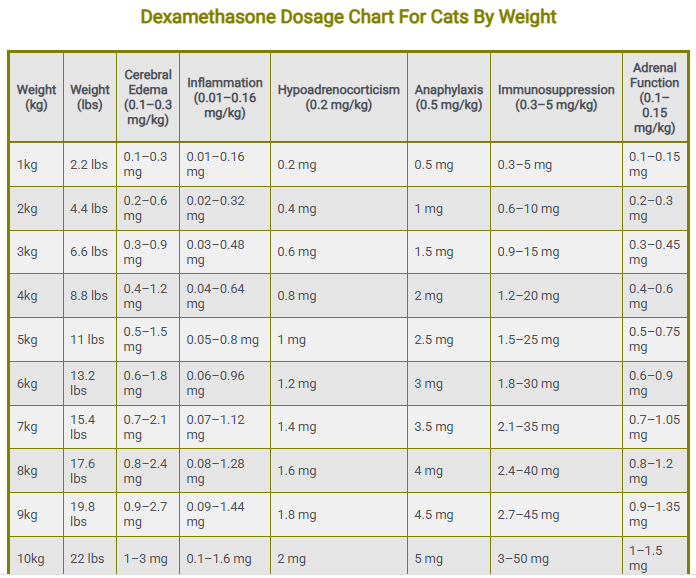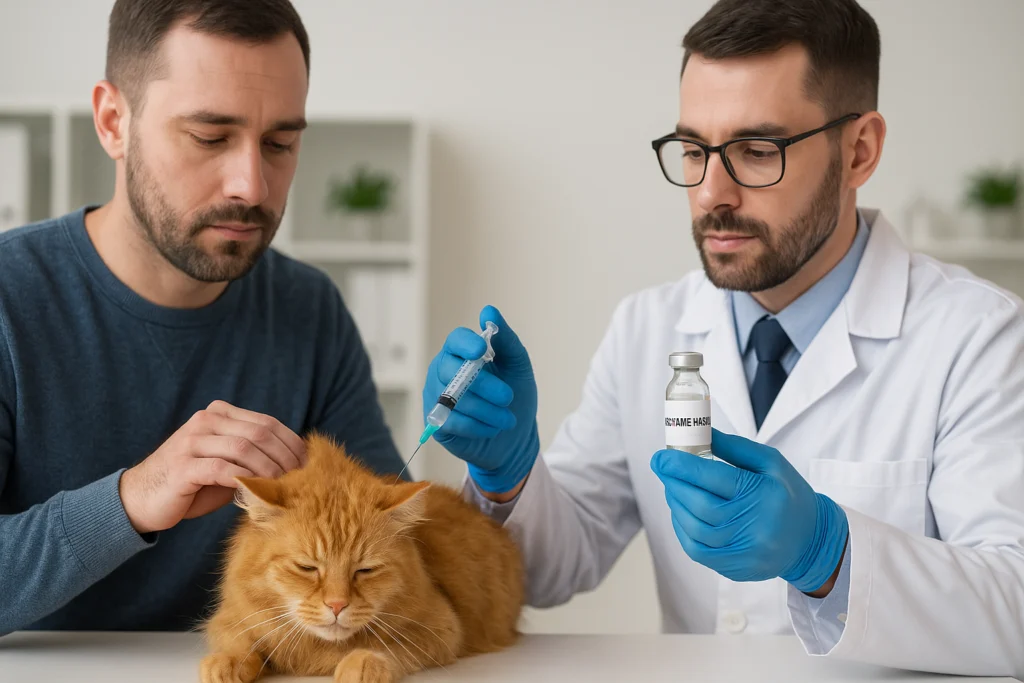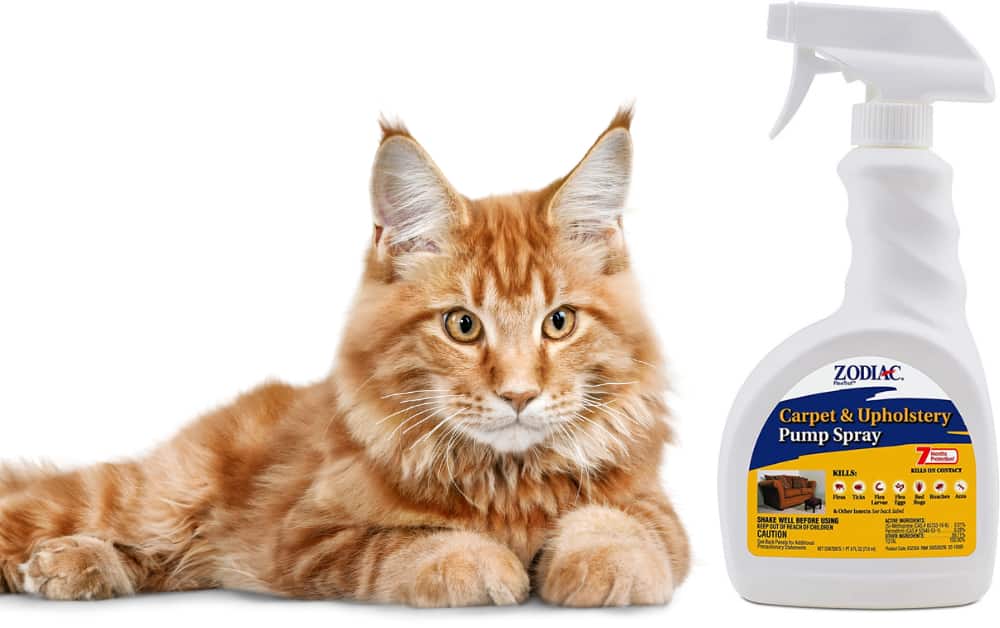If your vet just prescribed dexamethasone for your cat, you’re likely filled with questions—how much should I give, what’s it for, and is it safe? Dexamethasone is a powerful corticosteroid with a wide range of uses in veterinary medicine. But like any potent drug, it demands precision, understanding, and caution. In this article, we’ll dig deep into how dexamethasone works, when it’s used, and most importantly, how to get the dosage right for your feline friend.
Let’s break it all down step-by-step, so you’re confident when it comes to your cat’s care.
Dexamethasone Dosage For Cats
Dexamethasone Dosage for Cats
- Ophthalmic: Apply ointment every 6–24 hours or instill 1 drop every 6–12 hours.
- Otic: Instill 10 drops in the ear once daily for 7–14 days.
- Cerebral edema: 0.1–0.3 mg/kg for anti-inflammatory effects.
- Inflammation: 0.01–0.16 mg/kg intramuscularly (i.m.), subcutaneously (s.c.), or orally (p.o.) every 24 hours for 3–5 days.
- Hypoadrenocorticism: 0.2 mg/kg intravenously (i.v.) daily until oral medication is possible.
- Anaphylaxis: 0.5 mg/kg i.v. as a single dose.
- Immunosuppression: 0.3–5 mg/kg i.m., s.c., or p.o. every 24 hours for up to 5 days.
- Adrenal function assessment: 0.1–0.15 mg/kg i.v.
Reference: vet-ebooks.com
Please make sure to consult your veterinarian before administering any dose to your feline friend.
Dexamethasone Dosage Chart For Cats By Weight
| Weight (kg) | Weight (lbs) | Cerebral Edema (0.1–0.3 mg/kg) | Inflammation (0.01–0.16 mg/kg) | Hypoadrenocorticism (0.2 mg/kg) | Anaphylaxis (0.5 mg/kg) | Immunosuppression (0.3–5 mg/kg) | Adrenal Function (0.1–0.15 mg/kg) |
|---|---|---|---|---|---|---|---|
| 1kg | 2.2 lbs | 0.1–0.3 mg | 0.01–0.16 mg | 0.2 mg | 0.5 mg | 0.3–5 mg | 0.1–0.15 mg |
| 2kg | 4.4 lbs | 0.2–0.6 mg | 0.02–0.32 mg | 0.4 mg | 1 mg | 0.6–10 mg | 0.2–0.3 mg |
| 3kg | 6.6 lbs | 0.3–0.9 mg | 0.03–0.48 mg | 0.6 mg | 1.5 mg | 0.9–15 mg | 0.3–0.45 mg |
| 4kg | 8.8 lbs | 0.4–1.2 mg | 0.04–0.64 mg | 0.8 mg | 2 mg | 1.2–20 mg | 0.4–0.6 mg |
| 5kg | 11 lbs | 0.5–1.5 mg | 0.05–0.8 mg | 1 mg | 2.5 mg | 1.5–25 mg | 0.5–0.75 mg |
| 6kg | 13.2 lbs | 0.6–1.8 mg | 0.06–0.96 mg | 1.2 mg | 3 mg | 1.8–30 mg | 0.6–0.9 mg |
| 7kg | 15.4 lbs | 0.7–2.1 mg | 0.07–1.12 mg | 1.4 mg | 3.5 mg | 2.1–35 mg | 0.7–1.05 mg |
| 8kg | 17.6 lbs | 0.8–2.4 mg | 0.08–1.28 mg | 1.6 mg | 4 mg | 2.4–40 mg | 0.8–1.2 mg |
| 9kg | 19.8 lbs | 0.9–2.7 mg | 0.09–1.44 mg | 1.8 mg | 4.5 mg | 2.7–45 mg | 0.9–1.35 mg |
| 10kg | 22 lbs | 1–3 mg | 0.1–1.6 mg | 2 mg | 5 mg | 3–50 mg | 1–1.5 mg |
What is Dexamethasone?
Dexamethasone for cats is a synthetic corticosteroid—basically, a lab-made version of hormones that your cat’s adrenal glands naturally produce. It’s primarily used to reduce inflammation, suppress the immune system, or treat conditions that stem from hormonal imbalances. Think of it like a fire extinguisher: when the immune system overreacts or the body is in crisis, dexamethasone steps in to calm the flames.
In veterinary medicine, this drug is valued for its potency and fast-acting nature. It’s often stronger and longer-lasting than other steroids like prednisone, which is why vets choose it for acute or serious cases. It’s available in various forms—tablets, injections, and sometimes even topical creams, although injections and tablets are most common for cats.
But this power comes with a catch—because it’s so strong, even small miscalculations in dosage can lead to significant side effects. That’s why understanding how it works and sticking closely to your vet’s instructions is absolutely critical.
How It Works in Feline Physiology
Dexamethasone mimics the action of cortisol, a hormone that regulates inflammation, blood sugar, metabolism, and immune responses. When given in precise doses, it suppresses immune system activity and blocks substances that cause inflammation.
For example, if your cat has an allergic reaction or autoimmune condition, dexamethasone can dramatically reduce the symptoms by preventing immune cells from releasing histamines or attacking the cat’s own tissues. In some cases, it can even save a life.
However, it also affects other systems—causing changes in appetite, mood, water retention, and more. That’s why dosage isn’t a one-size-fits-all deal.
Why Is Dexamethasone Prescribed for Cats?
Dexamethasone has a wide range of applications in feline medicine. Here are some of the most common conditions it’s used to treat:
- Allergic reactions (like flea allergies, food allergies, or environmental allergens)
- Asthma or bronchial inflammation
- Inflammatory Bowel Disease (IBD)
- Autoimmune diseases such as pemphigus
- Brain swelling due to trauma or infection
- Shock or severe infections (as a supportive therapy)
- Certain types of cancer (especially lymphoma)
Each of these conditions involves inflammation or an overactive immune response. The goal of dexamethasone is to reduce that inflammation quickly and protect vital organs from damage.
How to Administer Dexamethasone to Your Cat
Administering medicine to a cat is no small feat—we all know how finicky they can be! Whether you’re using a pill or liquid form, here are some tips:
- Hide pills in treats or pill pockets.
- Use a pill popper for easier administration.
- Crush and mix with a small amount of tuna or wet food (only if your vet approves—some meds lose potency when crushed).
For liquid forms, use a syringe and gently squirt the medicine into the cheek pouch. Always reward your cat afterward to make the process more tolerable.
Pro Tip: Give dexamethasone around the same time each day to maintain consistent blood levels.
Duration of Treatment and Monitoring
Short-term treatment might last just a few days for allergic reactions or inflammation. But for chronic conditions like IBD or asthma, it could go on for weeks—or even become part of a long-term care plan.
The key is regular monitoring:
- Watch for side effects like increased thirst, urination, panting, or behavioral changes.
- Frequent check-ups may be required, including blood tests or urine analysis.
- Adjustments might be needed if your cat gains or loses weight, or if symptoms return.
Dexamethasone isn’t a “set it and forget it” medication—it demands ongoing attention.
Adjusting Dosage: Tapering and Long-term Use
Tapering is essential if your cat has been on dexamethasone for more than a few days. Why? Because steroids suppress the natural production of cortisol. If you stop suddenly, your cat’s adrenal glands may not “wake up” fast enough, leading to serious health risks like adrenal insufficiency.
A tapering schedule might look like this:
- Week 1: Daily dosage
- Week 2: Every other day
- Week 3: Every third day
- Week 4: Discontinue (if vet approves)
Of course, this is just an example. Your vet will create a personalized plan based on your cat’s response and health status.
Dexamethasone Side Effects in Cats
Long-term dexamethasone use in cats comes with a laundry list of potential side effects, which is why regular monitoring is so important. These aren’t just minor inconveniences—they can be life-altering or even life-threatening if not caught early.
Common Side Effects Include:
- Increased thirst and urination: This is often the first sign of trouble. You might notice your cat spending more time at the water bowl or filling the litter box more than usual.
- Increased appetite: Some cats may start begging for food constantly, which can lead to weight gain.
- Lethargy or behavioral changes: A once-playful cat may become withdrawn, anxious, or irritable.
- Thinning skin or fur loss: Long-term corticosteroid use can weaken skin and lead to noticeable hair thinning or bald patches.
- Weakened immune system: Your cat may become more susceptible to infections, including urinary tract infections, skin issues, or respiratory illnesses.
If you notice any of these symptoms, it’s time to call your vet. Don’t wait. A minor sign can quickly escalate into something more serious.
Rare But Serious Risks
In some cats, prolonged dexamethasone use can lead to:
- Cushing’s Disease (Hyperadrenocorticism): Caused by an overproduction of cortisol or long-term steroid use. Symptoms include potbelly appearance, muscle weakness, and extreme thirst.
- Diabetes Mellitus: Steroids can increase blood glucose levels. Cats may start losing weight rapidly while eating normally—or even more than usual.
- Gastrointestinal ulcers or bleeding: If your cat starts vomiting blood, has black tarry stools, or seems to be in pain, it’s an emergency. Seek immediate veterinary care.
Key Monitoring Recommendations:
- Schedule regular blood work to check liver enzymes and glucose levels
- Monitor weight weekly using a pet scale
- Track water intake by measuring daily water consumption
- Watch for skin changes during routine grooming
- Report behavioral changes to your vet immediately
Long-Term Care and Special Considerations
In some cases, long-term or even lifelong use of dexamethasone is justified, especially if it’s the only effective treatment for a chronic condition like:
- Asthma
- IBD
- Autoimmune skin disorders
If other treatments fail or cause worse side effects, your vet may determine that the benefits of continued steroid therapy outweigh the risks.
However, it’s important to explore alternative or complementary therapies when possible:
- Diet changes: Hypoallergenic diets can significantly help in conditions like IBD.
- Supplements: Probiotics, omega-3 fatty acids, and immune modulators may reduce the need for high steroid doses.
- Other medications: Drugs like cyclosporine or newer immunosuppressants may be better suited for long-term use with fewer risks.
A Note on Geriatric Cats
Older cats often have multiple health conditions—arthritis, kidney issues, thyroid imbalances. Steroid use in these cases must be especially careful. Kidney disease and diabetes can be worsened by dexamethasone, so dosages may need to be lower, and vet visits more frequent.
If your cat is in their golden years, it’s even more critical to have a personalized care plan.
Drug Interactions and Contraindications
If your cat is on other medications, especially NSAIDs, insulin, antifungals, or antibiotics, you need to be cautious. Dexamethasone can interact with:
- Non-Steroidal Anti-Inflammatory Drugs (NSAIDs): Combining can increase the risk of ulcers.
- Diuretics: May cause imbalances in electrolytes like potassium.
- Vaccines: Steroids may suppress the immune response, reducing vaccine effectiveness.
- Insulin: May require dosage adjustments if dexamethasone raises blood sugar.
Always keep a current list of medications and supplements your cat is taking and share it with your vet.
When Dexamethasone Should Be Avoided
In some cases, dexamethasone is not recommended at all:
- Pregnant or nursing cats: Risk of fetal malformation or suppressed milk production.
- Cats with systemic fungal infections: Steroids weaken the immune system, making these infections worse.
- Cats with uncontrolled diabetes or hypertension: Steroids may worsen these conditions.
In these situations, your vet will likely explore safer alternatives.
Natural Alternatives and Complementary Therapies
While steroids like dexamethasone are incredibly effective, they aren’t the only tools in the toolbox. Depending on the condition, natural or holistic therapies might help reduce reliance on steroids or even replace them in milder cases.
Popular Alternatives Include:
- Fish oil (Omega-3s): Natural anti-inflammatory effects.
- Probiotics: Can help regulate the immune system and support gut health.
- CBD for Cats: Anecdotal evidence suggests anti-inflammatory and calming benefits, though more research is needed.
- Homeopathic or herbal remedies: Should be used with caution and under vet supervision.
These alternatives aren’t a one-size-fits-all solution, but in collaboration with your vet, they can often play a helpful role.
Emergency Situations and Overdose Management
Recognizing an Overdose
Overdosing a cat on dexamethasone isn’t just a slip-up—it can be a medical emergency. Because this medication affects so many systems in the body, too much of it can quickly push your cat into a crisis.
Here are the signs to watch for:
- Severe vomiting or diarrhea
- Rapid breathing or panting
- Muscle weakness or trembling
- Lethargy or collapse
- High blood sugar symptoms (frequent urination, weight loss, increased thirst)
- Behavioral changes like aggression or extreme anxiety
If you notice any of these symptoms and suspect an overdose, call your vet or an emergency clinic immediately. Quick action can make all the difference.
First Aid and Vet Treatment
In the case of a known or suspected overdose, don’t try to treat it at home. Instead:
- Do not give any more doses.
- Note the amount and time of administration.
- Bring the medication with you to the clinic so the vet knows exactly what your cat ingested.
At the clinic, your cat may receive:
- IV fluids to flush out the drug
- Activated charcoal (if the drug was recently ingested)
- Medications to stabilize heart rate, blood pressure, and glucose levels
- Hospitalization and monitoring for complications like organ stress or shock
Overdoses are rare but serious—especially with a drug as potent as dexamethasone.
You May Also Like To Read:
Final Thoughts
Dexamethasone is a powerful and versatile medication that can bring immense relief to cats suffering from a range of serious conditions—from allergies and IBD to autoimmune disorders and even certain cancers. But with great power comes great responsibility. That’s why understanding the correct dosage, potential side effects, administration techniques, and long-term implications is absolutely critical.
This isn’t a drug to be taken lightly. But when used correctly—under the close guidance of your veterinarian—it can be life-changing for your feline friend.
So whether your cat is on a short course for an allergy flare or a long-term plan for a chronic condition, stay informed, stay observant, and always consult your vet when in doubt.
After all, your cat is counting on you—not just to administer the medication, but to make smart, safe decisions every step of the way.

FAQs
How long does dexamethasone stay in a cat’s system?
Typically, dexamethasone has a half-life of around 36–54 hours in cats. This means that it can remain active in the body for several days, which is why dosing schedules are so important. Even if you skip a dose, residual effects may still be present, so never double up on the next one without veterinary instruction.
Can I stop giving dexamethasone suddenly?
No. Never discontinue dexamethasone abruptly, especially after more than a few days of use. Stopping cold turkey can trigger an adrenal crisis—a dangerous condition where your cat’s body can’t produce enough cortisol on its own. Always consult your vet for a tapering plan to gradually wean your cat off the medication.
What’s the difference between dexamethasone and prednisone in cats?
While both are corticosteroids, dexamethasone is more potent than prednisone and often works faster. Vets may choose one over the other depending on the severity of the condition, how quickly they need results, and your cat’s medical history. However, dexamethasone often comes with a higher risk of side effects due to its strength.
How should I store dexamethasone for cats?
Keep it in a cool, dry place away from direct sunlight. Oral tablets and liquids should be stored at room temperature, usually between 68–77°F (20–25°C). Always keep it out of reach of children and pets, and make sure the cap is tightly sealed.
Can I give dexamethasone with food?
Yes, giving dexamethasone with food is generally recommended. It helps reduce the risk of stomach upset and may improve absorption. Some cats tolerate the medication better when it’s hidden in a small amount of tasty wet food.











